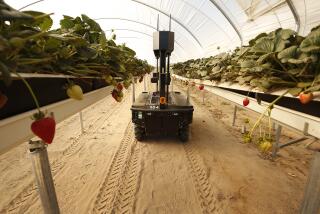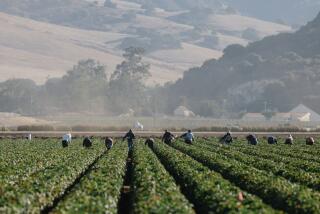California Farmers Push Plan to Legalize âDriverlessâ Tractors
SACRAMENTO â They are a strange sight: massive tractors rumbling across the table-flat fields of Californiaâs lush Central Valley and coastal farmland--with no driver at the wheel.
Drivers hop off and on moving tractors to work in the fields that produce more than half the nationâs fruits and vegetables. A state law forbids the practice, but it is rarely enforced.
Now, a group of farmers is petitioning the state to make it legal. The proposed change, to be considered at a hearing Sept. 25, would allow a driver to stray from the tractor with a remote-control engine âkill switchâ in his pocket.
Lining up against the proposal are tractor makers, many safety experts and those who would be most directly affected, farm workers.
âYou want more children to end up the way we did? Fatherless?â said 17-year-old Laura Martinez. âI never imagined my dad would die like that.â
Her father, Rafael Martinez, a veteran fieldworker with four children, was crushed to death in June by a driverless tractor towing two trailers on a cantaloupe farm in Coalinga.
He was a driver, but because it was also his job to count the filled boxes and place stickers on them when they were ready to ship, Martinez often climbed from the cab to the trailers that the tractor pulled. He did so while the tractor and its cargo were moving.
âI donât think he thought it was dangerous,â says his widow, Zaragoza Martinez. âBut they gave him more and more to do.â She is suing the tractor maker and the produce packing company.
In the 12 months to October 1997, three people were killed and two others suffered crushing injuries in California. Four others have been seriously injured by driverless tractors this decade, state officials say.
But interviews with workers suggest that number may be much higher because many injuries go unreported. Fieldworkers, many of them in the country illegally, say they are cowed into silence.
âThereâs women and men and families that are being placed in danger,â said a 32-year-old woman who works on a farm in the Santa Maria Valley. She declined to give her name, fearing retribution from her employer.
She said a driverless tractor once ran over the groin of a worker who had been napping on the field where she was working, and a woman in the country illegally suffered a miscarriage in the field after a driverless tractor accident.
Unattended tractors have veered onto state highways. In 1993, one reportedly scattered children from a Southern California playground and crashed into the monkey bars.
State law generally requires a driver in the cab, seat belt fastened.
But infrequent inspections have left the law without teeth, according to workers, farm worker advocates and state data. Since 1990, 59 citations for driverless tractors have been issued on Californiaâs 80,000 farms, according to the California Department of Industrial Relations.
âI can go any day of the week, even weekends, in any direction and drive 10 miles and find either three or four driverless tractors going,â said Mary Jacka, of the Santa Maria office of California Rural Legal Assistance, which opposes the practice.
On a recent weekday afternoon in a farm field about 200 miles up the coast from Los Angeles, a worker hopped into the cab of an unmanned, moving tractor when a photographer stopped to take pictures.
A state inspector last year found tractors rolling unmanned across the same field where Rafael Martinez had died three days earlier.
âIt comes down to economics,â said Bill Steinke, head of the farm safety program at UC Davis. âIf a person can get off the tractor, itâs one less person that has to be paid.â
Most farming states donât have rules about drivers and tractors.
Why then are 75 California growers seeking a variance from the rules in that state?
âI know for a lay person when you look at it, it doesnât seem logical,â said Richard Quandt, a representative of the group. âBut when you really look at the way the work is performed, there really is some sense.â
On many fruit and vegetable farms, tractors creep across the fields at 1 to 2 mph, slower than walking pace. They are self-guided by furrows in the field. Thereâs nothing to operate, and sitting in the cab in 100-degree temperatures can be stupefying.
Growers argue that an operator should follow the tractor and keep an eye on the workers. With âkill switchâ in hand, the driver could shut off the engine at the first sign of trouble.
On the tractor that killed Rafael Martinez, workers had heard there was such a switch but no one knew where it was, said Laura Martinez, who was working on the back of the tractor that killed her father.
The request for a variance is before the California Occupational Health and Safety Administration and would affect about 1,000 tractors harvesting row crops like lettuce, celery, broccoli, cauliflower and melons throughout the state.
But state safety officials say the varianceâs application would be so broad as to make enforcement âdifficult, if not impossible.â
Tractor makers also dislike the plan.
âGetting on and off a tractor when itâs in motion should not be permitted,â said Al Higley, spokesman for Deere & Co. of Moline, Ill., the worldâs largest tractor maker. âWe design the tractor to have an operator in the seat.â
Cal/OSHA is split. The agencyâs enforcement division has opposed the variance, citing safety concerns, but its Standards Board, which rewrites the rules, favors it. The board says requiring farmers to equip tractors with steel nonskid steps and to keep a trained driver within 10 feet of the tractor cab would make the practice safe.
Opponents of the variance privately concede that it is likely to pass in some form.
That troubles Laura Martinez, who relives the memory of her last day with her father. Just before the accident, he had been in the packing trailer and caught her eye.
âI just remember glancing at him and smiling at him and that was all,â she said. âThe next thing I heard was my dad screaming to my uncle to stop the tractor.â
More to Read
Sign up for Essential California
The most important California stories and recommendations in your inbox every morning.
You may occasionally receive promotional content from the Los Angeles Times.










